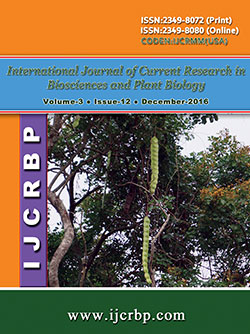 |
Online ISSN : 2349-8080 Issues : 12 per year Publisher : Excellent Publishers Email : editorinchiefijcrbp@gmail.com |
2Department of Histology and Cell Biology, Faculty of Medicine, Al-Mansoura University, Egypt
3Regional Center for Food and Feed, Agricultural Research Center, Cairo, Egypt
A feeding experiment was conducted with rats to reevaluate the possible toxic effects of very low level (tolerance limit) of ochratoxin A (OTA) and attempting to overcome this ochratoxicosis A via dietary supplementation of some essential oils. The obtained results revealed that the toxicated as well as garlic-oil groups of rats moisten their mats than the other groups' mats. Garlic-oil group also excreted more wet feces and had the lowest daily bodyweight gain as well as the worst feed conversion ratio comparing with the other groups. Garlic oil containing diets (whether with or without the toxin) reflected very low bone mineral density, whereas all toxic diets (with or without garlic or marjoram oils) and marjoram oil alone reflected high bone mineral concentration but the lowest value was obtained with garlic oil alone. Bone area was increased in all treatments, except garlic oil group. However, the highest area was in marjoram group. Lean mass was the lowest in the toxic diets with or without garlic oil. Fat mass was at lowest value in the toxic diet plus marjoram and the highest in the toxic diet plus garlic oil. OTA and/or the tested essential oils affected also the post-mortem, relative weights (particularly spleen), the blood profile (particularly Glob, Glu, AST, Cre, alkaline phosphatase, LDH, testosterone, lymphocytes, monocytes, and granulocytes), proximate analysis of the biological tissues, and the histological structure of the internal organs. So, even the very low concentration of OTA (25 ppb, as a dietary tolerance level in some countries) used in this study, it may be harmful and dietary essential oils inclusion could not completely overcome its toxic effects. So, it is still a fact that prevention (of mold growth) is easier, cheaper and more effective and better than curing of mycotoxicosis.
